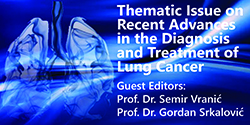The Effects of Helichrysum italicum Extract on the Extracellular Matrix of the Skin
DOI:
https://doi.org/10.5644/ama2006-124.425Keywords:
Helichrysum italicum, FGF-2, HAS-2, MMP-9Abstract
Objective. An in-vitro study was performed to investigate the molecular basis of the wound healing and skin protective features of Helichrysum italicum (HI), a medicinal plant from the Mediterranean basin.
Materials and Methods. A dermal fibroblast cell line culture was treated with HI hydro-alcoholic extract to detect the gene expression levels of three selected primers: FGF-2, HAS-2 and MMP-9. Cell proliferation assay was performed using a XTT reagent. RNA isolations were carried out from both the extract treated study cell group and the control cell group using a TRI reagent. GAPDH was used as the reference gene. Gene expressions were determined by real time RT-qPCR. The results were represented as ‘Target/GAPDH Fold Change’. Statistical evaluation was performed by Student’s t test.
Results. HI extract caused statistically significant upregulation of FGF-2 (P=0.0473) and HAS-2 (P=0.0335) gene expressions compared to the untreated control cells. The treatment ended with 1.74 and 3.10 fold changes for FGF-2 and HAS-2, respectively.
Conclusion. In general, it may be considered that HI has certain anabolic effects on the extracellular matrix of the skin because of the significant increases it causes in FGF-2 and HAS-2. Therefore, it may have a promising future in anti-aging studies and cosmetic dermatology. The results obtained in this study may also partially explain the molecular basis of the health benefits of HI on skin, including improvement in wound healing, and protection against the detrimental effects of ultraviolet exposure.
Downloads
Published
Issue
Section
License
Copyright (c) 2023 Erkin Pekmezci, Murat Türkoğlu

This work is licensed under a Creative Commons Attribution-NonCommercial 4.0 International License.






